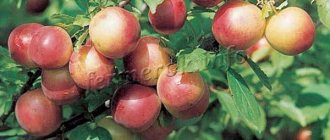Description of hazel
Hazel is a shrub that grows from 2 to 5 m in height. Its distribution area is Europe, the Caucasus and the Middle East. The bush is found in deciduous and coniferous forests.
The top of the plant has the shape of a ball or oval. The surface of the bark is smooth and has a brown-gray color. The shoots are thin, brown with a gray tint, and have slight pubescence over the entire surface. The rhizome is powerful and develops over 3 years. First, the main taproot is formed, and then shoots extending to the sides.
Did you know? According to ancient Slavic belief, on the eve of Trinity, the souls of deceased relatives move into the branches of a hazel tree.
.
The buds are ovoid in shape. They reach a length of 3 mm, their color is red or brown. The leaf blades are light green in color. The leaf shape is oval, pointed at the top and jagged along the edges. Its length can reach 12 cm and width - 9 cm. The nuts are single-seeded with a dense shell. The shape of the fruit is spherical, slightly pointed towards the top. The shell color is light brown or grayish.
Hazelnut propagation methods
Few people know, but hazel, or as everyone is used to calling it, hazelnut, belongs to the birch family. Such a shrub, and sometimes a tree, can reach up to 10 meters in height. The leaves of the plant are large and petiolate, usually wide and oval in shape with slightly rounded ends. This culture is loved for its amazing taste and very healthy fruits. You can eat nuts either raw or use them to prepare various delicacies. Hazelnuts can be propagated in a summer cottage in several ways. Among them, the following methods are especially popular:
- Seminal;
- By dividing the bush and layering;
- Rhizomatous shoots or peelings;
- By grafting or cuttings.
Hazelnuts are propagated by rhizome shoots if a summer resident wants to renew hazel in nature. In this case, the bush will grow in a circle with rhizomes. Formation will occur due to dormant buds every year. From the moment of planting with such propagation, the hazel shoots will develop in a couple of years. Summer residents rarely resort to this method of reproduction, since it has its own nuances. It is no less difficult to propagate hazel through grafting. In this option, two types of seedlings are needed for the rootstock. Hazel is often grafted in order to quickly grow a new shrub of a valuable variety. This is done using cuttings in early spring. Moreover, cuttings for this purpose are used exclusively from the middle of the shoot or its lower part.
How to propagate hazelnuts will be discussed in more detail in this video.
Hazelnut cuttings at home
Hazelnut is one of the cultivated varieties of hazel. When propagating it at home, you can use the cuttings method, but you must remember that this method is very difficult for an ordinary gardener.
To succeed, it is necessary to provide the cuttings with special conditions:
- high humidity;
- nutrient composition of the soil.
Green branches for rooting must be cut from late June to mid-July.
Take shoots 15–20 cm long. They should have 5 buds. To root the cuttings, prepare a special substrate consisting of peat and river sand, taken in equal proportions. The growing container must have drainage holes. It is filled with a mixture of peat and sand and the cutting is inserted to a depth of about 2 cm. Before performing this action, the lower cut of the branch is treated with Kornevin powder, and the upper cut is covered with garden pitch.
When the planting process is completed, the plant is watered with a small amount of water. Pots with cuttings must be kept in greenhouse conditions, for which the following structure can be built on the site:
- Dig a trench approximately 1–1.5 m long, depending on the amount of material to be germinated. Its width should be 40–50 cm.
- You need to place a film along the entire length of the trench and secure it along the edges in any convenient way - for example, with stones placed along the edges.
- The resulting tank is filled with water, approximately to the middle.
- Bricks are immersed in water to form a stand for containers with cuttings. It should be 20–30 cm above the water level.
- After placing the containers over the trench, iron or plastic arcs are installed and the film is stretched.
In such conditions, rooting is easier, and after 2 months a full-fledged seedling is obtained. If it is not possible to build a trench, the plant will need constant moistening of the air and soil. In order for roots to form on the cuttings, you can use the cutting technique in newspaper.
To carry out this process you need:
- Cut shoots 20 cm long.
- Wrap the cuttings in several layers of newspaper so that there are no gaps left.
- Next, moisten the resulting roll generously with water and place it in a plastic bag or container.
- Every week the newspaper must be unrolled and replaced with a new one. Inspect the cuttings for the presence of mold and rot - if any, the shoot is removed.
- The process of root formation can last from 4 to 8 weeks.
You can also propagate by cuttings at home, in a regular plastic bag. To do this you will need:
- Take a thick transparent bag and fill a third of it with a mixture of peat and sand.
- Treat the cut cuttings with the preparation “Kornevin” and insert them into the substrate in a bag 3 cm deep.
- Seal the bag at the top and carefully place it on the windowsill.
- It can take 6 to 12 weeks for rhizomes to form under such conditions.
Features of grafting hazel onto bear nut
A very effective technique for accelerating the growth and establishment of cuttings is fusion in a pipe. The plant is placed in a polypropylene sewer pipe at the grafting site. Warm air is supplied through it at a temperature of up to +25°C - this will improve fusion. The rest of the plant is kept cool (not lower than +12-13°C).
A slot is made in the pipe into which the seedling is inserted. Next, the pipe is wrapped with some kind of material, without affecting the lower and upper parts of the tree. You can prevent the scion part from drying out by spreading it with garden varnish. The air can be heated by a heating cable or from a hot furnace.
Growth occurs within three weeks; trees take root under such conditions in 98% of cases.
Further care for hazelnuts
Rooted cuttings are transplanted into larger containers for growing. During this period, plant care should be regular. The soil in pots should be loosened 2 times a month. Watering is carried out as the earthen clod dries.
Important! To prevent the formation of a dense earthen crust around the trunk, which prevents the rhizome from receiving oxygen, the soil is loosened to a depth of 10 cm 2-3 times a month.
By the fall of next year, the cuttings will produce full-fledged seedlings that can be planted in open ground for further cultivation of hazel. The planting pit is prepared 1-2 months before the planting process. Dig a hole 60 cm deep and 50 cm wide. Fertilizers consisting of 10 kg of humus, 60 g of potassium sulfate and 200 g of wood ash are applied to the bottom of the pit. This mixture is mixed with chernozem and left until the seedling is planted.
Step-by-step instructions for planting hazel:
- Loosen the soil in the already prepared hole.
- Water the ground with 5 liters of water.
- Introduce the seedling by carefully spreading the rhizome along the ground.
- Fill the top of the hole with ordinary soil and compact it tightly.
- Pour 10 liters of water. Mulch the tree trunk circle with peat or sawdust.
Further care of the plant consists of timely watering and fertilizing. Hazelnuts should be irrigated 2 times a month or more often, depending on weather conditions. Water is introduced into a specially dug trench near the trunk, its quantity is 10–15 liters per adult shrub.
Find out also what is the difference between hazel and hazelnut.
Hazel needs to be fed with organic fertilizers, which are applied once every 2 years. For digging, take 5 kg of humus per 1 m². Mineral fertilizers are supplied in the form of the OMU preparation, which includes a mixture of nitrogen, phosphorus, potassium, magnesium and humic compounds. Fertilizer is used in an amount of 60 g per 1 m², it is applied by digging up the soil or scattering it.
How to plant hazelnuts from nuts
Before planting a plant, you need to choose the right hazelnut variety. It must be suitable for growing in a particular region, and also not be afraid of the local climate and weather conditions. The correct hazelnut varieties to plant in central Russia are:
- The president;
- Futkurami;
- Circassian.
They have protected seeds that are suitable for local soils. These types of hazel grow much faster than their young counterparts. They begin to bear fruit from 7 years after planting. If you follow all the rules for care, the harvest will be of high quality, tasty and contain all the necessary nutrients.
Interesting!
After flowering, the hazel tree bears fruit. If there is no negative impact from the outside, then you can get 2.5 kg of harvest from one bush. On average, it ranges from 700 to 1,200 ripe nuts. Each of them weighs about two grams.
Other ways to propagate hazel
Hazelnuts can reproduce by grafting, seed and layering. To propagate hazelnuts by seeds, you need to carefully select planting material. To do this, the best nuts that are free from chips, diaper rash and other defects are selected from the harvested crop. The seeds are immersed in water for 5 days, after which they are dried and placed in a plastic bag with wet sand for further stratification. The container with nuts is kept in a dark place at a temperature from 0°C to +5°C. The process lasts about 4 months, and with the onset of a thaw, the nuts are planted in the ground.
To propagate by layering, in early spring you need to dig a trench near the bush. It should be up to 8 cm deep and up to 50 cm long. A shoot 1.5 m long is bent to this groove and pinched to the ground approximately in the middle with a wooden hook, after which the trench is covered with soil. So the layer will be bent in the form of an arc. The remaining part of the shoot on the surface must be tied to a peg. By autumn, the cuttings will form a rhizome and will be ready to be transplanted to a new location.
Vaccination is carried out in the spring. As a hazelnut rootstock, you can take Bear nut or Common hazel. A branch is selected on the plant on which to graft. A cut is made on it and the bark is split a little. The scion is prepared from annual shoots on which an oblique cut is made. A shoot is inserted into a split in the bark and tightly wrapped with electrical tape to the rootstock.
So, propagating hazelnuts by cuttings is a rather labor-intensive process. But, if you follow all the rules and be patient, you can get high-quality seedlings with good immunity and productivity.
How to choose a place to plant hazelnuts
Many people wonder how to plant hazelnuts correctly so as to get the maximum amount of useful harvest from each bush. Let's look at the basic conditions for achieving maximum results.
- The nature of the soil.
- Selected location.
- Illumination.
Each of these factors influences the growth, formation and fruiting of the hazelnut tree.
If you breed correctly, you can grow a good plant that will produce a lot of high-quality harvests every year. It is best to choose soil located on the northwestern and northeastern sides of the garden plot as soil. Typically these areas have moist, nutrient-rich soil.
Interesting!
If the soil contains a large amount of salt, then hazelnuts as a plant will feel bad here. This will become the main obstacle to the full growth and development of the hazel tree, as well as to obtaining a harvest.











